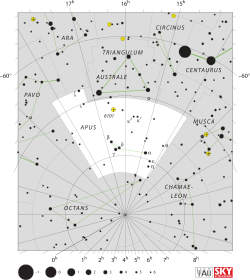Theta Apodis

| |
| Observation data Epoch J2000 Equinox J2000 | |
|---|---|
| Constellation | Apus |
| Right ascension | 14h 05m 19.87784s[1] |
| Declination | –76° 47′ 48.3204″[1] |
| Apparent magnitude (V) | 5.7[2] |
| Characteristics | |
| Spectral type | M7 III[2] |
| U−B color index | +1.07[3] |
| B−V color index | +1.48[3] |
| Variable type | Semiregular[2] pulsating |
| Astrometry | |
| Radial velocity (Rv) | +9.0[4] km/s |
| Proper motion (μ) | RA: –87.54[1] mas/yr Dec.: –32.54[1] mas/yr |
| Parallax (π) | 8.84 ± 0.49[1] mas |
| Distance | 370 ± 20 ly (113 ± 6 pc) |
| Absolute magnitude (MV) | 0.7[2] |
| Other designations | |
Theta Apodis (θ Aps, θ Apodis) is the Bayer designation for a star in the southern circumpolar constellation of Apus. It is a variable star with a mean apparent visual magnitude of 5.7,[2] which, according to the Bortle Dark-Sky Scale, means it is a faint star but visible to the naked eye from dark suburban skies. The distance to Theta Apodis is approximately 370 light-years (110 parsecs), based upon parallax measurements made from the Hipparcos spacecraft.[1] It is unusual in that it is a red star with a high proper motion (greater than 50 milliarcseconds a year).[6]
This is an evolved red giant that is currently on the asymptotic giant branch,[7] with a stellar classification of M7 III.[2] It shines with a luminosity approximately 3879 times that of the Sun and has a surface temperature of 3151 K.[8] It is a semiregular pulsating variable and its brightness changes over a range of 0.56 magnitudes with a period of 119[2] days. It is losing mass at the rate of 1.1 × 10−7 times the mass of the Sun per year through its stellar wind. Dusty material ejected from this star is interacting with the surrounding interstellar medium, forming a bow shock as the star moves through the galaxy. The stand-off distance for this front is located at about 0.134 ly (0.041 pc) from Theta Apodis.[7]
Theta Apodis has been identified as an astrometric binary, indicating that it has an orbiting companion that causes gravitational perturbation of the primary star.[9]
References
- 1 2 3 4 5 6 van Leeuwen, F. (November 2007), "Validation of the new Hipparcos reduction", Astronomy and Astrophysics, 474 (2): 653–664, arXiv:0708.1752
 , Bibcode:2007A&A...474..653V, doi:10.1051/0004-6361:20078357.
, Bibcode:2007A&A...474..653V, doi:10.1051/0004-6361:20078357. - 1 2 3 4 5 6 7 Yeşilyaprak, C.; Aslan, Z. (December 2004), "Period-luminosity relation for M-type semiregular variables from Hipparcos parallaxes", Monthly Notices of the Royal Astronomical Society, 355 (2): 601–607, Bibcode:2004MNRAS.355..601Y, doi:10.1111/j.1365-2966.2004.08344.x.
- 1 2 Wisse, P. N. J. (May 1981), "Three colour observations of southern red variable giant stars", Astronomy and Astrophysics Supplement Series, 44: 273–303, Bibcode:1981A&AS...44..273W.
- ↑ Feast, M. W.; Woolley, R.; Yilmaz, N. (1972), "The kinematics of semi-regular red variables in the solar neighbourhood", Monthly Notices of the Royal Astronomical Society, 158: 23–46, Bibcode:1972MNRAS.158...23F, doi:10.1093/mnras/158.1.23.
- ↑ "tet Aps -- Semi-regular pulsating Star", SIMBAD, Centre de Données astronomiques de Strasbourg, retrieved 2012-07-08.
- ↑ Jiménez-Esteban, F. M.; Caballero, J. A.; Dorda, R.; Miles-Páez, P. A.; Solano, E. (2012). "Identification of red high proper-motion objects in Tycho-2 and 2MASS catalogues using Virtual Observatory tools". Astronomy & Astrophysics. 539: 12. arXiv:1201.5315
 . Bibcode:2012A&A...539A..86J. doi:10.1051/0004-6361/201118375.
. Bibcode:2012A&A...539A..86J. doi:10.1051/0004-6361/201118375. - 1 2 Cox, N. L. J.; et al. (January 2012), "A far-infrared survey of bow shocks and detached shells around AGB stars and red supergiants", Astronomy & Astrophysics, 537: A35, arXiv:1110.5486
 , Bibcode:2012A&A...537A..35C, doi:10.1051/0004-6361/201117910. See table 1, IRAS 14003-7633.
, Bibcode:2012A&A...537A..35C, doi:10.1051/0004-6361/201117910. See table 1, IRAS 14003-7633. - ↑ McDonald, I.; Zijlstra, A. A.; Boyer, M. L. (2012). "Fundamental Parameters and Infrared Excesses of Hipparcos Stars". Monthly Notices of the Royal Astronomical Society. 427 (1): 343–57. arXiv:1208.2037
 . Bibcode:2012MNRAS.427..343M. doi:10.1111/j.1365-2966.2012.21873.x.
. Bibcode:2012MNRAS.427..343M. doi:10.1111/j.1365-2966.2012.21873.x. - ↑ Eggleton, P. P.; Tokovinin, A. A. (September 2008). "A catalogue of multiplicity among bright stellar systems". Monthly Notices of the Royal Astronomical Society. 389 (2): 869–879. arXiv:0806.2878
 . Bibcode:2008MNRAS.389..869E. doi:10.1111/j.1365-2966.2008.13596.x.
. Bibcode:2008MNRAS.389..869E. doi:10.1111/j.1365-2966.2008.13596.x.